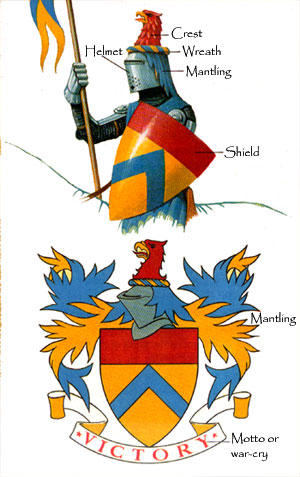|
Ye Olde Blazoner Online Shop Heraldry
|
A Coat of Arms
 From
the illustration opposite, it is easy to imagine how a coat of arms may
have originated.
From
the illustration opposite, it is easy to imagine how a coat of arms may
have originated.
Today, coats of arms are found in all sorts of places - castles, churches, town halls, on public transport, in building societies, banks, offices and schools. Some of these are not true heraldic coats of arms, but merely elaborate badges. Genuine lawful arms are granted by the authority of the officers of the College of Arms and are generally designed by them.
The building up of a coat of arms is quite difficult, as it must be an accurate pictoral record of what is represented. Sometimes details may have to be traced back for hundreds of years.
Special technical terms are used to describe the different features. Heraldry has its own language, built up mainly from Norman-French, Latin and early English. Because heraldry first came to us from France through Germany, some of its terms are also ancient German, so it is truly a mixture of languages.
The background of a coat of arms is a shield (escutcheon), which may be one of the various shapes. If the owner is an unmarried lady or a widow, it is diamond shaped and called a lozenge.
The surface of this shield is termed the field.

